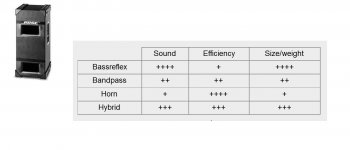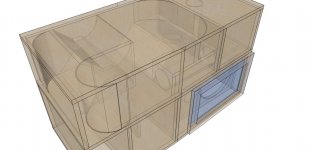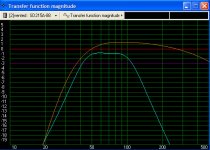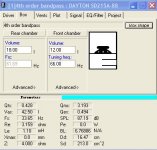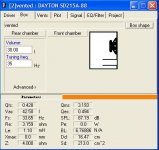This forum is full of audio guys that have been doing this for many years and I in no way can stack up to them in experience or knowledge. I wanted to register to this specifically so I can learn from some very intelligent people.
Well occasionally I have some dumb questions and don't feel like signing up to some other forum where my questions will be considered acceptable so here I go.
I've done some reading and research and cannot find anywhere why exactly do people bother with bandpass enclosures? I can't seem to find any reason they are better than a normal sealed, ported or even infinite baffle setup. All I find is alot of problems and complications with this design.
1. Bandpass subwoofer enclosure increase your chance of blowing the woofer.
2. Bandpass enclosures from what I can tell are not louder or better sounding (SQ)
3. They are extremely complicated to build and are not forgiving for even the smallest mistakes.
4. the boxes are huge so space is not saved like in a IB setup.
5. some have many ports which I assume adds to the port noise, and a bandpass enclosure tuned to a particular frequency from what I learned will not put out much more at that frequency than a ported enclosure tuned to same frequency.
I understand you can build a bandpass where the sound is played from both ends of the woofer, so you get more output. but the same thing is achieved with a ported box
So what gives, is there some factor I am missing here or are they just built for the hell of it, "because I can" type of thing?
Well occasionally I have some dumb questions and don't feel like signing up to some other forum where my questions will be considered acceptable so here I go.
I've done some reading and research and cannot find anywhere why exactly do people bother with bandpass enclosures? I can't seem to find any reason they are better than a normal sealed, ported or even infinite baffle setup. All I find is alot of problems and complications with this design.
1. Bandpass subwoofer enclosure increase your chance of blowing the woofer.
2. Bandpass enclosures from what I can tell are not louder or better sounding (SQ)
3. They are extremely complicated to build and are not forgiving for even the smallest mistakes.
4. the boxes are huge so space is not saved like in a IB setup.
5. some have many ports which I assume adds to the port noise, and a bandpass enclosure tuned to a particular frequency from what I learned will not put out much more at that frequency than a ported enclosure tuned to same frequency.
I understand you can build a bandpass where the sound is played from both ends of the woofer, so you get more output. but the same thing is achieved with a ported box
So what gives, is there some factor I am missing here or are they just built for the hell of it, "because I can" type of thing?
OK Let me chime in first
Greetings and Welcome to the forum.
I've been building speakers for 41 years and have never considered a band-pass for anything. That doesn't necessarily make them bad, I just have never had any interest. Other memebers here may have, and might like to post their results.
I am a bit puzzled by your post. You state you can't see any advantge to a band-pass, so why are you even dwelling on it ?
Greetings and Welcome to the forum.
I've been building speakers for 41 years and have never considered a band-pass for anything. That doesn't necessarily make them bad, I just have never had any interest. Other memebers here may have, and might like to post their results.
I am a bit puzzled by your post. You state you can't see any advantge to a band-pass, so why are you even dwelling on it ?
Greetings and Welcome to the forum.
I've been building speakers for 41 years and have never considered a band-pass for anything. That doesn't necessarily make them bad, I just have never had any interest. Other memebers here may have, and might like to post their results.
I am a bit puzzled by your post. You state you can't see any advantge to a band-pass, so why are you even dwelling on it ?
Thank you for the reply,
I don't know what you mean by dwelling on it, I'm simply learning. I guess I'm a information ninja!

I was just seeing if there is something else I am missing or haven't learned yet that would make a bandpass enclosure make sense, I guess a good follow up question is; in what scenario is a bandpass enclosure practical if any?
Actually IMHO there is nothing stupid at all about this question as I ponder it. Perhaps the thread ought to be renamed as I think it will get a lot more attention if you pose the question directly in the title. I can change it for you, just let me know by PM.
Edit: Thread title updated after PM request. I am quite curious to hear the answers myself.
Edit: Thread title updated after PM request. I am quite curious to hear the answers myself.
1. Bandpass subwoofer enclosure increase your chance of blowing the woofer.
2. Bandpass enclosures from what I can tell are not louder or better sounding (SQ)
3. They are extremely complicated to build and are not forgiving for even the smallest mistakes.
4. the boxes are huge so space is not saved like in a IB setup.
5. some have many ports which I assume adds to the port noise, and a bandpass enclosure tuned to a particular frequency from what I learned will not put out much more at that frequency than a ported enclosure tuned to same frequency.
 You can read here.
You can read here.JL Audio header Support Tutorials Tutorial: Bandpass Enclosure Characteristics
Steinigke Blog (english) Overview on subwoofer types
Patent US1969704 - ACOUSTIC DEVICE - Google Patents
Attachments
Last edited:
I've actually read that, still didn't see any significant improvement in any department.
What have the people that have built a bandpass box used it for on this forum?
Edit: der... That's a similar but slightly different article, reading through now
Last edited:
...why exactly do people bother with bandpass enclosures? I can't seem to find any reason they are better than a normal sealed, ported or even infinite baffle setup. All I find is alot of problems and complications with this design.
1. Bandpass subwoofer enclosure increase your chance of blowing the woofer.
2. Bandpass enclosures from what I can tell are not louder or better sounding
3. They are extremely complicated to build and are not forgiving for even the smallest mistakes.
4. the boxes are huge so space is not saved like in a IB setup.
5. some have many ports which I assume adds to the port noise, and a bandpass enclosure tuned to a particular frequency from what I learned will not put out much more at that frequency than a ported enclosure tuned to same frequency.
1. Depends on implementation
2. Depends on implementation
3. More complicated than sealed or vented, but not extremely so.
4. Depends on implementation
5. Depends on implementation
Think of it as degrees of freedom. For a given woofer, a sealed box has one (box size), a ported has two (Size and tuning), a 4th order bandpass has three (sealed and vented volumes and tuning) and a 6th order bandpass has 4 (2 volumes and 2 tunings). More degrees of freedom means more chance to shape the response to your liking. Their inherent lowpass characteristic makes them most useful as subs.
Bandpass enclosures can be designed with more or less sensitivity than the woofer, with narrow or wide (not more than ~1.5-2 octaves though) bandwidth. The filter of the port can reduce distortion (and perhaps lead to more stress on the woofer). Box sizes are typically on par with a vented box for similar sensitivity and similar F3, but with a slower rolloff (in the case of 4th order).
Premade bandpass boxes give them a bad name - some very high end speakers (KEF to name one) have used bandpass enclosures.
1. Depends on implementation
2. Depends on implementation
3. More complicated than sealed or vented, but not extremely so.
4. Depends on implementation
5. Depends on implementation
Think of it as degrees of freedom. For a given woofer, a sealed box has one (box size), a ported has two (Size and tuning), a 4th order bandpass has three (sealed and vented volumes and tuning) and a 6th order bandpass has 4 (2 volumes and 2 tunings). More degrees of freedom means more chance to shape the response to your liking. Their inherent lowpass characteristic makes them most useful as subs.
Bandpass enclosures can be designed with more or less sensitivity than the woofer, with narrow or wide (not more than ~1.5-2 octaves though) bandwidth. The filter of the port can reduce distortion (and perhaps lead to more stress on the woofer). Box sizes are typically on par with a vented box for similar sensitivity and similar F3, but with a slower rolloff (in the case of 4th order).
Premade bandpass boxes give them a bad name - some very high end speakers (KEF to name one) have used bandpass enclosures.
Okay thank you, that cleared up some of it.
I guess if you have a problem with a particular frequency you could use a bandpass to work that out?
I guess my confusion was stemmed in, why would some one build a bandpass that increases the volume of let's say the 30hz area, when they can use some type of eq to get that to their liking without all the trouble of a bandpass.
Or use a ported box tuned to the same frequency.
I guess it's really a toy that is more useful to people that build stuff to experiment than something used in a practical application?
I suppose the KEF engineers put in a ton of time into designing it to sound right, I doubt they were able to design a speaker that is better in some single way than other high quality speakers designed with a different approach.
1. Depends on implementation
2. Depends on implementation
3. More complicated than sealed or vented, but not extremely so.
4. Depends on implementation
5. Depends on implementation
Think of it as degrees of freedom. For a given woofer, a sealed box has one (box size), a ported has two (Size and tuning), a 4th order bandpass has three (sealed and vented volumes and tuning) and a 6th order bandpass has 4 (2 volumes and 2 tunings). More degrees of freedom means more chance to shape the response to your liking. Their inherent lowpass characteristic makes them most useful as subs.
Bandpass enclosures can be designed with more or less sensitivity than the woofer, with narrow or wide (not more than ~1.5-2 octaves though) bandwidth. The filter of the port can reduce distortion (and perhaps lead to more stress on the woofer). Box sizes are typically on par with a vented box for similar sensitivity and similar F3, but with a slower rolloff (in the case of 4th order).
Premade bandpass boxes give them a bad name - some very high end speakers (KEF to name one) have used bandpass enclosures.
I competely agree. I've built bandpasses before. More complicated? Hardly. Time consuming yes, but not complicated IF you take necessary precautions first so you don't make rookie mistakes. If you make mistakes, you're a rookie.
If one can successfuly design AND properly implement (meaning verify with measurements) sealed and vented bass-reflex enclosures, designing and properly implementing a bandpass is not all that different.
Aleksrussion, which books do you currently own that go over the topics of designing sealed/bass-reflex loudspeaker enclosures?
Last edited:
I competely agree. I've built bandpasses before. More complicated? Hardly. Time consuming yes, but not complicated IF you take necessary precautions first so you don't make rookie mistakes. If you make mistakes, you're a rookie.
What was your application? How come you chose the bandpass over the other options?
There are advantages in limiting the bandwidth- this is particularly useful if you want to add a sub section to a speaker without adding a plate amp or some pricey 15mH coils.
Also, the distortion can be quite low, output quite high, and the drivers are inherently protected from physical damage, and also from excursion damage in a 4th order box as they don't unload below tuning the way a vented cab does.
Also, the distortion can be quite low, output quite high, and the drivers are inherently protected from physical damage, and also from excursion damage in a 4th order box as they don't unload below tuning the way a vented cab does.
Sure if you can't build this just right the first timeyou're a rookie and its "hardly" anymore complicated haha
That is not representative of what a bandpass enclosure "has to" look like. They are only as complicated as you make them out to be. Knowledge is key. Even in actual practice, they can be very very simple.
I competely agree. I've built bandpasses before. More complicated? Hardly. Time consuming yes, but not complicated IF you take necessary precautions first so you don't make rookie mistakes. If you make mistakes, you're a rookie.
If one can successfuly design AND properly implement (meaning verify with measurements) sealed and vented bass-reflex enclosures, designing and properly implementing a bandpass is not all that different.
Aleksrussion, which books do you currently own that go over the topics of designing sealed/bass-reflex loudspeaker enclosures?
I don't own any books, mostly Internet research. I have only done a few boxes
That is not representative of what a bandpass enclosure "has to" look like. They are only as complicated as you make them out to be. Knowledge is key. Even in actual practice, they can be very very simple.
Lol I understand I was just being sarcastic
What was your application? How come you chose the bandpass over the other options?
The application was: build an enclosure for a friend's car.
He wanted loud (as possible), plain and simple. At the time I was perhaps 22 or 23 yrs old, and bandpasses were as "advanced" as I could get. The speaker was a 12" that he had already purchased. Luckily when I measured the T/S parameters, they worked out well in a 6th order BP. I think it was a Sony Xplod or something like that. It had crap for Xmax, something like 4-6mm. With a 6th order BP, I could tailor the two distinct tuning frequencies close to each other (in conjunction with the proper volumes of course) to keep the cone excursion under control under a lot of power (way more than a sealed or bass-reflex would be able to accept).
The result was an enclosure about 30-40% larger than a similar sized bass-reflex with the same F3 on the low-end, BUT it was ~6dB more sensitive throughout it's passband than the bass-reflex/sealed would have been.
That's a problem right there. You won't find many books going into extreme detail on bandpass boxes, but with a good solid understanding of the work of Thiele/Small on sealed and vented bandpass enclosures, you could have already been armed with the knowledge that RonE posted. Don't wait (hope) for someone on the internet to spoon feed you the specific info you need on anything. The info/knowledge is out there in books. Using free modeling software would be a good investment of your time. Most of the free stuff is limited to small-signal analysis, but it's a step in the right direction until your level of expertise naturally leads you to study large-signal non-linear loudspeaker behavior.I don't own any books
Last edited:
The application was: build an enclosure for a friend's car.
He wanted loud (as possible), plain and simple. At the time I was perhaps 22 or 23 yrs old, and bandpasses were as "advanced" as I could get. The speaker was a 12" that he had already purchased. Luckily when I measured the T/S parameters, they worked out well in a 6th order BP. I think it was a Sony Xplod or something like that. It had crap for Xmax, something like 4-6mm. With a 6th order BP, I could tailor the two distinct tuning frequencies close to each other (in conjunction with the proper volumes of course) to keep the cone excursion under control under a lot of power (way more than a sealed or bass-reflex would be able to accept).
The result was an enclosure about 30-40% larger than a similar sized bass-reflex with the same F3 on the low-end, BUT it was ~6dB more sensitive throughout it's passband than the bass-reflex/sealed would have been.
That's a problem right there. You won't find many books going into extreme detail on bandpass boxes, but with a good solid understanding of the work of Thiele/Small on sealed and vented bandpass enclosures, you could have already been armed with the knowledge that RonE posted. Don't wait (hope) for someone on the internet to spoon feed you the specific info you need on anything. The info/knowledge is out there in books. Using free modeling software would be a good investment of your time. Most of the free stuff is limited to small-signal analysis, but it's a step in the right direction until your level of expertise naturally leads you to study large-signal non-linear loudspeaker behavior.
I understand, one step at a time though, I don't plan on building a bandpass box.
I just wanted some solid information on the various boxes and where they apply best. I've been able learn what I consider enough information on sealed and ported boxes for my current projects, but wanted a little bit more insight on bandpass because I wasn't able to find sufficient information on the subject hence this thread. I don't ever plan on discontinuing my research completely, but at the moment I am satisfied with all but bandpass and the hybrid stuff but that's another topic.
I understand a book would be quite helpful, but currently I am not interested in spending money on books when I at the moment have no use for a bandpass.
As a matter of fact if someone here was to able to show me an application of a bandpass enclosure that would have applied to my situation I would seriously consider books and the like to learn enough to make one, but so far the applications described here and throughout the web haven't shown any reasonable advantage, atleast to me.
Hello Aleksrussian
I think the points in your first post are misguided. Bandpass subs can sound very good, sometimes even better than Bass Reflex.
I finished testing a Dayton SD125A-88 Sub (Bass Reflex). I will be testing it out in a 30 Liters Bandpass when time permits.
Below are some sims. TS are extracted with DATS.
Regards
Mike
I think the points in your first post are misguided. Bandpass subs can sound very good, sometimes even better than Bass Reflex.
I finished testing a Dayton SD125A-88 Sub (Bass Reflex). I will be testing it out in a 30 Liters Bandpass when time permits.
Below are some sims. TS are extracted with DATS.
Regards
Mike
Attachments
Hello Aleksrussian
I think the points in your first post are misguided. Bandpass subs can sound very good, sometimes even better than Bass Reflex.
I finished testing a Dayton SD125A-88 Sub (Bass Reflex). I will be testing it out in a 30 Liters Bandpass when time permits.
Below are some sims. TS are extracted with DATS.
Regards
Mike
Maybe I'm reading the information wrong, but to me it looks like that is not very good results. Tuning frequency is 60hz?? Maybe bandpass doesn't work the same way but a tuning frequency of above 40hz would sound terrible in a typical ported box.
Also are there QTC parameters for that? I see Qts but I assume thats not the same thing
Tuning for Bandpass is different from Ported Box. At 66Hz, it gives a flat response. If the BP is tuned for 40Hz, you'll get a very sharp peak at that frequency.
Bandpass is very flexible. The response need not always be flat. You can change the volume and tuning to shape the response that you prefer.
Why would that be terrible.
Qtc is for Closed Box.
Bandpass is very flexible. The response need not always be flat. You can change the volume and tuning to shape the response that you prefer.
....but a tuning frequency of above 40hz would sound terrible in a typical ported box.
Why would that be terrible.
Also are there QTC parameters for that?
Qtc is for Closed Box.
- Status
- This old topic is closed. If you want to reopen this topic, contact a moderator using the "Report Post" button.
- Home
- Loudspeakers
- Subwoofers
- Why bandpass enclosure?
